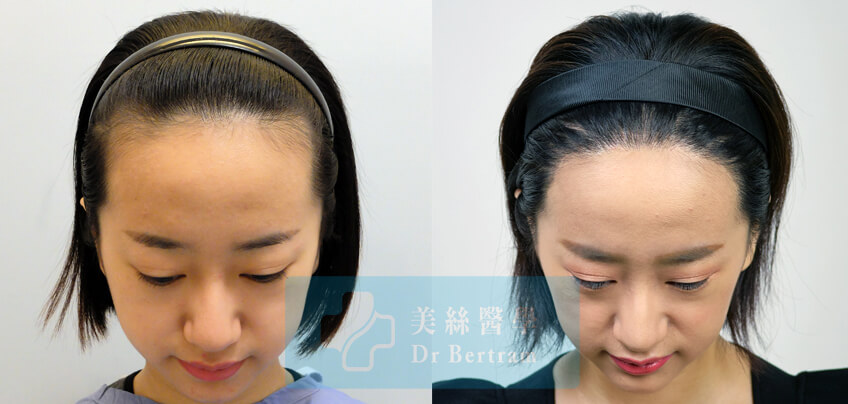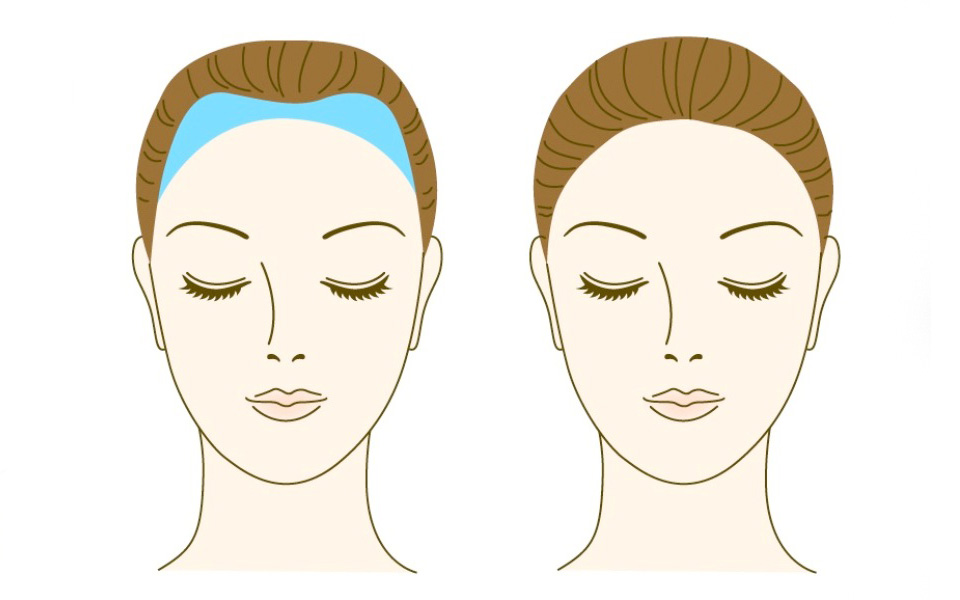Who Should Consider Hair Transplant?

Indications
1. High Forehead
Ladies born with a high forehead or M-shaped hairline without obvious hair loss. Hair transplants is the best option to fill-in the front hairline; and to thicken the front half of the scalp.
2. Female Pattern Hair Loss (FPHL)
A form of Androgenetic Alopecia accounting for 20-30% of hair thinning in women
3. Scarring Alopecia
Hair loss from scar after surgery or injury
Who are Good Candidate?
An ideal candidate is someone with dense hair in the permanent fringe of hair-bearing scalp which is at the side and back part of your head. A patient with light-colored hair and pale skin (as opposed to dark hair and light skin) may appear to have a denser look. Patients with very wavy curly hair may require fewer sessions than someone with straight hair.
Expectation must be realistic. While hair transplants look very natural, the end result may not achieve the density or total coverage of that of a teenager. Results can also vary from patient to patient. The patients have to accept that a second procedure may be needed in the future to catch up with progressive loss of existing hairs.
Hair Transplant Not Recommended For:
• Unrealistic Expectation, Perfectionist, Body Dysmorphic Syndrome
• Extensive thinning of hair over the entire scalp, with Miniaturization of 50% or more of the hair
• Unable to tolerate shock loss (see below)
Surgical Plan 1 - High Forehead

Objectives
A high forehead will increase the vertical height of the upper face. This will upset the facial proportion for beauty. On the other hand, a male pattern M-shaped hairline will be difficult to style, looking less feminine. The Da Vinci's Golden of Third is often used to restore attractiveness. Hair follicles can be transplanted in 3 ways:
• To fill up the corners
• To lower the hairline
• To re-shape the hairline
Patient Selection
Over 95% are good candidates for Hairline Transplant if donor hair is of reasonable quality. Anyone who has experienced permanent hair loss may be a candidate. Reasonable result in most cases in achieving a more feminine look. Expectation however must be reasonable.
Number of Grafts
Thinning area is limited and well defined. 1,800 to 2,400 grafts can achieve a reasonable and long-lasting improvement.
Selected Areas
Priority is the fronto-temporal triangles (apexes), whilst lowering the hairline is optional
Technique
Based on the individual's hair quality, we will recommend technique to suit individual need:
• FUT
• FUE
Number of sessions
Good result can be achieved after just one session. A touch-up procedure may be needed to thicken certain areas.
Shock Loss
Mainly confined to the donor area
Adjuvant Therapy
No long term medication is required to sustain the transplanted hair. FPHL, if present, should be treated accordingly
Must Read : How We Restore Hairline in Women >>
Surgical Plan 2 - Diffuse Hair Loss

Selecton of Patients
Anyone who has experienced progressive thinning from front to crown along the mid-line or part-line may be a candidate. This pattern can occur in young women but more common in post-menopausal women. The adding of density to the part-line can create good cosmetic result and allow more styling.
Patient must be of reasonable Expectation, whatever improvement achieved should be considered worthwhile in relation to the inconvenience, discomfort, and cost of the procedure. Hair transplant creates density but not thick hair. “ Do not want to see their scalp “ is an unrealistic goal as even women without significant loss can see their scalps.
Not Good Candidates for Hair Transplant
• Unrealistic Expectation, Perfectionist, Body Dysmorphic Syndrome
• Extensive thinning of hair over the entire scalp, with Miniaturization of 50% or more of the hair
• Unable to tolerate shock loss (see below)
Number of Grafts
Their finer hair, limited donor supply and risk of shock loss would not allow very dense packing. On average we transplant 1,800 to 2,400 grafts on the first session
Selected Areas
The center parting +/- the crown
Technique
Based on the individual's hair quality, we will recommend technique to suit individual need:
• FUT
• FUE
Number of sessions
1 to 2 sessions depending on too many factors
Shock Loss
Highly unpredictable and can be quite alarming! Overall 25-50% of patients experience temporal hair loss adjacent to donor and recipient sites about 3 weeks after surgery. Thinning areas can be camouflaged by applying Toppik, or by wearing a wig until hair starts to regrow after 3 to 4 months
Adjuvant Therapy
Shock Loss can be reduced by applying Minoxidil before and after surgery. Long term use of Minoxidil +/- laser therapy is highly recommended to slow down the progression of FPHL
Surgical Plan 3 - Scarring Alopecia

Patient Selection
Anyone who has experienced permanent hair loss may be a candidate. Not all scalp scar can be repaired, especially keloid. Improvement is possible, whether it is an atrophic or a hypertrophic scar. One must accept that not 100% of transplanted grafts will grow. Doctor consultation is mandatory.
Number of Grafts
We prefer to transplant a lower density in the first procedure as graft survival drops when too tightly packed
Selected Areas
Depending on the size of the scar
Technique
Based on the individual's hair quality, we will recommend technique to suit individual need:
• FUT
• FUE
Number of sessions
Usually 2 sessions are required to compensate for the compromised local circulation
Shock Loss
Mainly confined to the donor area
Adjuvant Therapy
No long term medication is required to sustain the transplanted hair. FPHL, if present, should be treated accordingly

